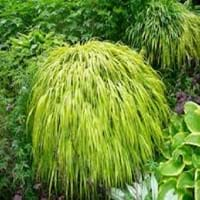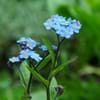Life Span
Perennial
Perennial
Type
Flowering Plants, Shrubs
Grass
Origin
Africa, America, Asia
Japan
Types
Lockinch, Petite Indigo, White Profusion
Not Available
Number of Varieties
Not Available
Habitat
Along Railroads, River side, Roadsides
meadows, Riverbanks, Wet Woods
USDA Hardiness Zone
5-10
5-9
Sunset Zone
H1, 2a, 2b, 3a, 3b, 4, 5, 6, 7, 8, 9, 10, 11, 12, 13, 14, 15, 16, 17, 18, 19, 20, 21, 22, 23, 24
1a, 1b, 2a, 2b, 3a, 3b, 4, 5, 6, 7, 8, 9, 10, 11, 12, 13, 14, 15, 16, 17, 18, 19, 20, 21, 22, 23, 24
Habit
Arching/Fountain-shaped
Clump-Forming
Flower Color
Blue, Pink, Purple, Red, White
Blue Violet
Flower Color Modifier
Not Available
Bicolor
Fruit Color
Not Available
Purple
Leaf Color in Spring
Gray Green
Yellow, Green, Light Green
Leaf Color in Summer
Gray Green, Light Green
Light Green
Leaf Color in Fall
Gray Green, Light Green, Yellow green
Orange, Yellow green, Orange Red
Leaf Color in Winter
Not Available
Green, Dark Green, Not Available
Leaf Shape
Egg-shaped
Oblovate
Plant Season
Fall, Spring, Summer, Winter
Spring, Summer, Fall
Sunlight
Full Sun, Part sun, Partial shade
Full Sun, Partial Sun, Partial shade
Type of Soil
Loamy, Sandy, Well drained
Loam
The pH of Soil
Neutral, Slightly Acidic, Slightly Alkaline
Acidic, Neutral
Soil Drainage
Well drained
Well drained
Bloom Time
Spring
Late Summer, Early Fall, Fall
Tolerances
Drought, Pollution, Salt, Soil Compaction
Dry soil, Shallow soil
Where to Plant?
Ground, Pot
Ground
How to Plant?
Seedlings, Stem Planting, Transplanting
From Rhizomes
Plant Maintenance
Medium
Medium
Watering Requirements
Form a Soil ring to water efficiently, Water Deeply, Water twice a day in the initial period
Keep ground moist
In Summer
Lots of watering
Lots of watering
In Spring
Moderate
Consistently
In Winter
Average Water
Adequately
Soil pH
Neutral, Slightly Acidic, Slightly Alkaline
Acidic, Neutral
Soil Type
Loamy, Sandy, Well drained
Loam
Soil Drainage Capacity
Well drained
Well drained
Sun Exposure
Full Sun, Part sun, Partial shade
Full Sun, Partial Sun, Partial shade
Pruning
Cut or pinch the stems, Prune for shortening long shoots, Prune if you want to improve plant shape, Prune ocassionally, Remove damaged leaves, Remove dead or diseased plant parts, Remove deadheads, Remove shoots
Prune grass to maintain level, Prune if you want to improve plant shape
Fertilizers
All-Purpose Liquid Fertilizer
organic fertlizers
Pests and Diseases
Downy mildew, Leaf spot, Spider mites
Not Available
Plant Tolerance
Drought
Shade areas, Shallow soil, Wet Site
Flowers
Yes
Insignificant
Flower Petal Number
Single
Single
Foliage Texture
Medium
Medium
Foliage Sheen
Matte
Matte
Attracts
Butterflies, Hummingbirds
Ants, Beetles, Caterpillar
Allergy
Vomiting
allergic conjunctivitis, Asthma, Rash
Aesthetic Uses
Showy Purposes
Beautification, Ground Cover
Beauty Benefits
Not Available
Not Available
Environmental Uses
Air purification
Provides ground cover, Shadow Tree
Medicinal Uses
Not Available
Acne, Aging, Laxative
Part of Plant Used
Flowers, Leaves
Leaves
Other Uses
Showy Purposes, Used as Ornamental plant
Can be made into a herbal tea, Showy Purposes
Used As Indoor Plant
No
Sometimes
Used As Outdoor Plant
Yes
Yes
Garden Design
Edging, Feature Plant, Foundation
Container, Edging, Mixed Border, Rock Garden / Wall, Water Gardens
Botanical Name
Buddleia davidii
HAKONECHLOA macra 'Aureola'
Common Name
Butterfly Bush, Summer Lilac, Butterflybush
Golden Japanese Forest Grass, Hakone Grass
In Hindi
Butterfly Bush
जापानी वन घास
In German
Schmetterlingsstrauch
Japanische gras
In French
buisson de papillon
Forêt herbe japonaise
In Spanish
arbusto de las mariposas
forestales hierba japonesa
In Greek
Butterfly Μπους
Ιαπωνικά γρασίδι δάσος
In Portuguese
arbusto de borboleta
floresta grama japonês
In Polish
Butterfly Bush
Japoński las lato
In Latin
papilio rubo
Forest gramina Italica
Phylum
Spermatophyta
Angiosperms
Class
Dicotyledonae
Monocots
Family
Scrophulariaceae
Poaceae
Genus
Buddleja
Hachanechloa
Clade
Angiosperms, Asterids, Eudicots
Angiosperms
Tribe
Not Available
Not Available
Subfamily
Not Available
Arundinariinae
Number of Species
Not Available
Season and Care of Butterfly Bush and Japanese Forest Grass
Season and care of Butterfly Bush and Japanese Forest Grass is important to know. While considering everything about Butterfly Bush and Japanese Forest Grass Care, growing season is an essential factor. Butterfly Bush season is Fall, Spring, Summer and Winter and Japanese Forest Grass season is Fall, Spring, Summer and Winter. The type of soil for Butterfly Bush is Loamy, Sandy, Well drained and for Japanese Forest Grass is Loam while the PH of soil for Butterfly Bush is Neutral, Slightly Acidic, Slightly Alkaline and for Japanese Forest Grass is Acidic, Neutral.
Butterfly Bush and Japanese Forest Grass Physical Information
Butterfly Bush and Japanese Forest Grass physical information is very important for comparison. Butterfly Bush height is 7.50 cm and width 4.00 cm whereas Japanese Forest Grass height is 30.50 cm and width 30.50 cm. The color specification of Butterfly Bush and Japanese Forest Grass are as follows:
Butterfly Bush flower color: Blue, Pink, Purple, Red and White
Butterfly Bush leaf color: Gray Green
Japanese Forest Grass flower color: Blue Violet
- Japanese Forest Grass leaf color: Yellow, Green and Light Green
Care of Butterfly Bush and Japanese Forest Grass
Care of Butterfly Bush and Japanese Forest Grass include pruning, fertilizers, watering etc. Butterfly Bush pruning is done Cut or pinch the stems, Prune for shortening long shoots, Prune if you want to improve plant shape, Prune ocassionally, Remove damaged leaves, Remove dead or diseased plant parts, Remove deadheads and Remove shoots and Japanese Forest Grass pruning is done Prune grass to maintain level and Prune if you want to improve plant shape. In summer Butterfly Bush needs Lots of watering and in winter, it needs Average Water. Whereas, in summer Japanese Forest Grass needs Lots of watering and in winter, it needs Adequately.





